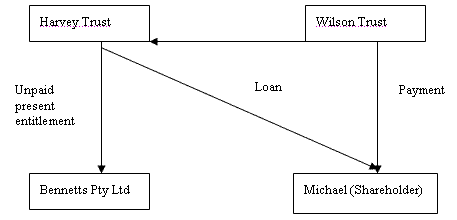Draft Taxation Determination
TD 2010/D9
Income tax: Division 7A - unpaid present entitlements - factors the Commissioner will take into account in determining the amount of any deemed entitlement arising under section 109XI of the Income Tax Assessment Act 1936
-
Please note that the PDF version is the authorised version of this draft ruling.This document has been finalised by TD 2011/15.There is a Compendium for this document: TD 2011/15EC .
 This publication provides you with the following level of protection:
This publication provides you with the following level of protection:
This publication is a draft for public comment. It represents the Commissioner's preliminary view about the way in which a relevant taxation provision applies, or would apply to entities generally or to a class of entities in relation to a particular scheme or a class of schemes. You can rely on this publication (excluding appendixes) to provide you with protection from interest and penalties in the following way. If a statement turns out to be incorrect and you underpay your tax as a result, you will not have to pay a penalty. Nor will you have to pay interest on the underpayment provided you reasonably relied on the publication in good faith. However, even if you don't have to pay a penalty or interest, you will have to pay the correct amount of tax provided the time limits under the law allow it. |
Ruling
1. Where section 109XI of the Income Tax Assessment Act 1936 (ITAA 1936)[1] operates to treat a private company as being or becoming presently entitled to an amount from the income of the target trust for the purposes of paragraphs 109XA(1)(c), 109XA(2)(b) and 109XA(3)(b), in determining the amount of this entitlement under subsection 109XI(4), the Commissioner will take into account relevant factors occurring before the earlier of the due date for lodgment and the date of lodgment of the target trust's return of income (the 'lodgment date') for the year of income in which the actual transaction referred to in section 109XA (the 'section 109XA transaction') takes place.
2. In respect of each and every year in which there is a section 109XA transaction and the conditions in subsection 109XI(1) are satisfied, the Commissioner will be required under subsection 109XI(4) to determine the amount (if any) that the private company is taken to be or to become entitled to from the net income of the target trust. The Commissioner will make this determination taking into account relevant factors existing immediately before the target trust's lodgment date for the year in which the section 109XA transaction occurred (the 'determination time').
3. The relevant factors that the Commissioner will take into account include:
- (a)
- the extent to which the present entitlements referred to in subsection 109XI(1) and any present entitlement of a trust interposed between the target trust and the company as part of the arrangement referred to in paragraph 109XI(1)(b) (an 'interposed trust') remain unpaid immediately before the determination time, noting that the total amount determined by the Commissioner must not exceed the amount that an interposed trust referred to in that subsection is entitled to from the net income of the target trust at that time;
- (b)
- amounts included, by the determination time, in the assessable income of a shareholder (or an associate of a shareholder) of the company under Subdivision EA as a result of the company's actual present entitlement to an amount from an interposed trust (rather than an amount the company is taken to be or become entitled to pursuant to section 109XI);
- (c)
- how much (if any) of the amount the private company became entitled to from the interposed trust referred to in paragraph 109XI(1)(a) that represents arm's length consideration payable to the company by the target trust or any interposed trusts referred to in that subsection for anything;
- (d)
- whether any payment of a present entitlement is a genuine transaction and not designed to avoid the application of Subdivision EA otherwise than as envisaged within the scheme of Division 7A (such as genuinely and in substance paying an entitlement by the relevant lodgment date or putting a relevant loan under a loan agreement as described in section 109N).
4. As a consequence of taking account of the matters referred to above and where the Commissioner is satisfied that the transactions are genuine and not designed to avoid the application of Subdivision EA otherwise than as envisaged within the scheme of Division 7A, the Commissioner will determine that where subsection 109XI(1) is satisfied, the amount the private company is taken to be, or to become, entitled to from the net income of the target trust will not exceed the lesser of:
- (a)
- the amount to which any interposed trust is, or becomes, presently entitled to from the net income of another interposed trust or the target trust that remains unpaid at the determination time;
- (b)
- the amount to which the company is, or becomes, presently entitled to from the net income of the interposed trust referred to in paragraph 109XI(1)(a) that remains unpaid at the determination time, reduced by:
- •
- any amount that is included in the assessable income of a shareholder (or an associate of a shareholder) of the company under Subdivision EA in respect of that actual present entitlement; and
- •
- any amount of this entitlement that represents arm's length consideration payable to the company by the target trust or any interposed trusts referred to in that subsection for anything.
Example 1
5. Judy is the trustee of Green Discretionary Trust and White Discretionary Trust.
6. Green Discretionary Trust is a beneficiary of White Discretionary Trust. On 30 June 2010, Judy, as trustee of White Discretionary Trust, exercises her discretion and resolves to distribute (but does not pay) $10,000 net income to Green Discretionary Trust for the 2009-10 income year.
7. Diamond Pty Ltd is a beneficiary of Green Discretionary Trust. On 30 June 2010, Judy, as trustee of Green Discretionary Trust, exercises her discretion and resolves to distribute (but does not pay) $7,000 net income to Diamond Pty Ltd for the 2009-10 income year.
8. A reasonable person would conclude that Diamond Pty Ltd became presently entitled to the amount of $7,000 solely or mainly as part of an arrangement involving an entitlement to an amount from White Discretionary Trust.
9. On 31 March 2010 Judy, as trustee of White Discretionary Trust made an interest free loan of $5,000 to Richard, a shareholder of Diamond Pty Ltd, which he used for private purposes.
10. During the 2009-10 income year there were no other payments or loans to, or debts forgiven of, any other shareholders (or associates of shareholders) of Diamond Pty Ltd, and Diamond Pty Ltd's distributable surplus (as defined in subsection 109Y(2)) for the year was well in excess of $10,000.
11. Because a reasonable person would conclude that Diamond Pty Ltd became entitled to $7,000 from Green Discretionary Trust as part of an arrangement involving Green Discretionary Trust's entitlement to $10,000 from White Discretionary Trust, Diamond Pty Ltd will be taken to have an entitlement to an amount from the net income of White Discretionary Trust under section 109XI.
12. This arrangement is set out in Diagram 1:
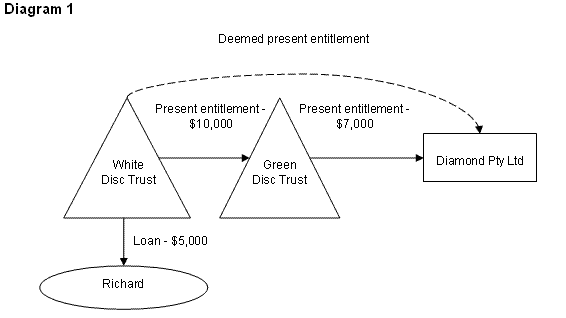
13. In determining the amount that Diamond Pty is taken to be presently entitled to from the income of White Discretionary Trust, the Commissioner will take into account relevant factors existing immediately before the determination time (that is, the 30 November 2010 lodgment date for White Discretionary Trust's return for the 2009-10 income year), including the fact that the lowest of the actual entitlements remaining unpaid at this time is $7,000.
14. For the purpose of paragraph 109XA(2)(b), the Commissioner therefore determines under subsection 109XI(4) that Diamond Pty Ltd is taken to be or to become entitled to an amount of $7,000 from the net income of the White Discretionary Trust at 30 June 2010, which remains unpaid before the White Discretionary Trust's lodgment date for the 2009-10 income year.
15. Subsection 109XB(1) applies, and $5,000 is included in Richard's assessable income for the 2009-10 income year in respect of his loan from White Discretionary Trust.
Example 2
16. This example has the same facts as in Example 1 except that the relevant entitlements are partially discharged before the determination time. $4,000 of the $10,000 that Green Discretionary Trust was presently entitled to from White Discretionary Trust was paid before the White Discretionary Trust's lodgment date for the 2009-10 income year (leaving a subsisting entitlement of $6,000 at that date) and $3,000 of the $7,000 Diamond Pty Ltd was presently entitled to from Green Discretionary Trust was paid before the White Discretionary Trust's lodgment date for the 2009-10 income year (leaving a subsisting entitlement of $4,000 at that date).
17. Diagram 2 sets out the subsisting arrangement as at the determination time (that is, the 30 November 2010 lodgment date for the White Discretionary Trust's return for the 2009-10 income year):
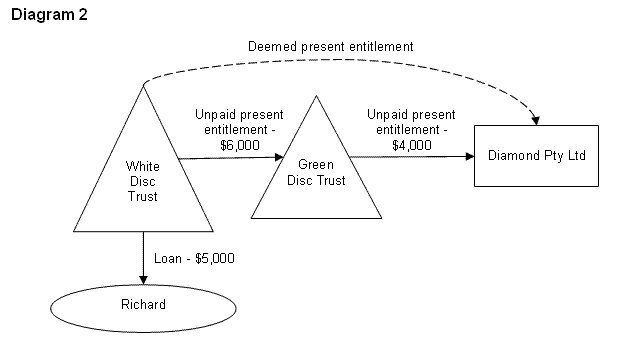
18. In determining the amount of that Diamond Pty is taken to be presently entitled to from the income of White Discretionary Trust, the Commissioner will take into account relevant factors existing immediately before the determination time (that is, the 30 November 2010 lodgment date for White Discretionary Trust's return for the 2009-10 income year), including the fact that the lowest of the actual entitlements remaining unpaid at this time is $4,000.
19. For the purpose of paragraph 109XA(2)(b) the Commissioner therefore determines under subsection 109XI(4) that Diamond Pty Ltd is taken to be or to become entitled to an amount of $4,000 from the net income of White Discretionary Trust at 30 June 2010, which remains unpaid at the White Discretionary Trust's lodgment date for the 2009-10 income year.
20. Subsection 109XB(1) applies and $4,000 is included in Richard's assessable income for the 2009-10 income year in respect of his loan from White Discretionary Trust.
Example 3
21. The Smith family conduct their business and investment activities through a number of trusts with a private company named as a discretionary object of one or more of those trusts.
22. Within the group it had been the practice for Joan Smith, as trustee of the Smith Business Trust (which carries on the main business activity of the family group) to distribute income to the Smith Investment Trust. The beneficiaries of the Smith Investment Trust include a private company in the group, Smith Pty Ltd. The distributions initially remain unpaid.
23. On 31 March 2010 Joan Smith, as trustee of the Smith Business Trust, made a loan of $10,000 to Jack Smith, a shareholder of Smith Pty Ltd. During preparation of the 2009-10 income tax returns for the group it was discovered that the conditions in subsection 109XI(1) had been satisfied and as a result Smith Pty Ltd was taken to entitled to an amount from the net income of The Smith Business Trust.
24. As none of the present entitlements referred to in subsection 109XI(1) had been paid to the respective beneficiaries, Subdivision EA of Division 7A potentially applied to the loan made to Jack Smith.
25. There are no other relevant facts and circumstances.
26. After identifying the Subdivision EA issue and prior to the Smith Business Trust's lodgment date, Joan Smith as trustee of the Smith Business Trust paid to the trustee of Smith Investment Trust the whole of the amount of the income of the Smith Business Trust that the Smith Investment Trust was presently entitled to receive.
27. In these circumstances the Commissioner would determine that the amount that Smith Pty Ltd is taken to be entitled to from net income of the Smith Business Trust to be $nil, the lowest of the present entitlements referred to in subsection109XI(1) that was outstanding at the determination time.
Example 4
28. The Brown family conduct their business and investment activities through a number of trusts with a private company named as a discretionary object of one or more of those trusts.
29. Within the group it had been the practice for Ben Brown, as trustee of the Brown Business Trust (the trust that carries on the main business activity of the group) to distribute income to the Brown Investment Trust, an interposed trust with the beneficiaries of that interposed trust including a private company in the group, Brown Pty Ltd. The distributions initially remain unpaid.
30. At 30 June 2010, Ben Brown, as trustee of the Brown Business Trust determined that the Brown Investment Trust was presently entitled to all of the distributable income of the Brown Business Trust. The trustee of the Brown Investment Trust determined that Brown Pty Ltd was presently entitled to all of the distributable income of the Brown Investment Trust for that year. No amount was paid to either beneficiary at this time.
31. On 1 July 2010, Ben Brown, as trustee of the Brown Business Trust, purchased property on credit terms from the trustee of the Brown Investment Trust. The purchase price of $10,000 was due and payable on 31 October 2011 in accordance with usual commercial terms.
32. On 31 August 2010 the accounts for the Brown Business Trust were finalised and it was determined that its distributable income (to which the Brown Investment Trust was 100% entitled), was $10,000. Its cash at bank was $20,000.
33. Contemporaneously, Belinda Brown was seeking to borrow $10,000. To facilitate a loan to Belinda Brown, Ben Brown as trustee of the Brown Business Trust agreed with the trustee of the Brown Investment Trust to defer payment of the amount outstanding on the property sale indefinitely. This allowed the distributable income of the Brown Business Trust to be loaned to Belinda as well as the present entitlement of the Brown Investment Trust to be fully discharged. The entire arrangement was conceived to allow Belinda Brown access to the net income of the Brown Business Trust by way of a loan from the trustee of the Brown Business Trust instead of as a distribution of company profits from Brown Pty Ltd.
34. Taking into account all relevant circumstances, the conditions in subsection 109XI(1) have been satisfied and as a result Brown Pty Ltd was taken to be, or to become, entitled to an amount from the net income of the Brown Business Trust.
35. In these circumstances the Commissioner would determine that the amount Brown Pty Ltd was taken to be entitled to is not the lesser of the amounts that remained unpaid at the determination time. There has been an attempt to circumvent Subdivision EA by the Brown Investment Trust replacing its equitable entitlement to receive an amount from the Brown Business trust with a contractual entitlement to be paid an amount from that trust.
Date of effect
36. When the final Determination is issued, it is proposed to apply both before and after its date of issue. However, the Determination will not apply to taxpayers to the extent that it conflicts with the terms of settlement of a dispute agreed to before the date of issue of the Determination (see paragraphs 75 to 77 of Taxation Ruling TR 2006/10).
Commissioner of Taxation
15 December 2010
Appendix 1 - Explanation
 This Appendix is provided as information to help you understand how the Commissioner's preliminary view has been reached. It does not form part of the proposed binding public ruling. This Appendix is provided as information to help you understand how the Commissioner's preliminary view has been reached. It does not form part of the proposed binding public ruling. |
Explanation
Background
37. Division 7A is an anti-avoidance or 'integrity' provision, directed to ensuring that disguised or informal distributions of company profits to shareholders or their associates should be included in the assessable income of the shareholders or associates.
38. Division 7A includes Subdivision EA which operates where a private company beneficiary has an unpaid present entitlement and the trustee of the trust makes a relevant payment or loan to, or forgives a debt owing by, a shareholder (or their associate) of the private company. If section 109XB applies in respect of the payment, loan or debt forgiven, an amount is included as if it were a dividend in the assessable income of the shareholder (or their associate).
39. The provisions in Subdivision EA are designed to ensure that a trustee cannot shelter trust income at the prevailing company tax rate by creating an unpaid present entitlement to a private company and then distributing the underlying cash to a shareholder (or their associate) of a private company.[2]
40. However, Subdivision EA does not apply in all circumstances where there is an unpaid present entitlement. For the purposes of Division 7A, 'loan' has an extended meaning and in addition to including ordinary loans, a 'loan' is defined to include the provision of credit or any other form of financial accommodation and transactions that in substance effect a loan of money. Private company beneficiaries with an unpaid present entitlement will be taken to make a loan to the trustee of the trust for Division 7A purposes in the circumstances described in Taxation Ruling TR 2010/3 Income tax: Division 7A loans: trust entitlements. If an unpaid present entitlement is considered to constitute a loan within the extended meaning then it will not be treated as a present entitlement that remains unpaid for the purposes of Subdivision EA.
41. For an amount to be included as if it were a dividend in the assessable income of a shareholder (or their associate) pursuant to section 109XB, the conditions in subsection 109XA(1) for payments, subsection 109XA(2) for loans and subsection 109XA(3) for forgiven debts, must be satisfied. For each of the subsections one of the conditions[3] is:
either:
- (i)
- the company is presently entitled to an amount from the net income of the trust estate at the time the actual transaction takes place, and the whole of that amount has not been paid to the company before the earlier of the due date for lodgment and the date of lodgment of the trustee's return of income for the trust for the year of income of the trust in which the actual transaction takes place; or
- (ii)
- the company becomes presently entitled to an amount from the net income of the trust estate after the actual transaction takes place, but before the earlier of the due date for lodgment and the date of lodgment of the trustee's return of income for the trust for the year of income of the trust in which the actual transaction takes place, and the whole of the amount has not been paid to the company before the earlier of those dates.
42. Prior to the introduction of Subdivision EB[4] one way this condition could be circumvented on its terms, as highlighted in Diagram 3, was to interpose one or more trusts between the trustee that entered into the section 109XA transaction with the shareholder (or their associate) and the private company.
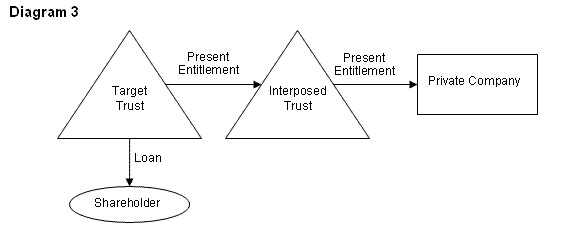
43. To enable Subdivision EA to apply to the loan made in the above circumstances section 109XI of Subdivision EB, which concerns entitlements to trust income through interposed trusts, provides that the private company is taken to be (at the time of the section 109XA transaction) or to become (before the target trust's lodgment date for the year in which the 109XA transaction occurred) entitled to an amount (determined by the Commissioner) from the net income of the Target Trust provided specified conditions are satisfied (see Diagram 4).
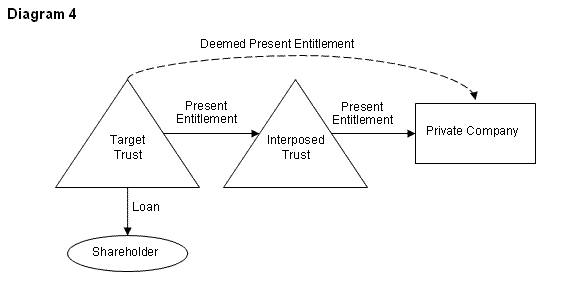
Section 109XI
44. Where there has been a section109XA transaction (such as the loan made by the target trust to the shareholder in Diagram 4), subsection 109XI(1) determines whether a private company is taken to be (at the time of the section109XA transaction) or become (after this time, but before the target trust's lodgment date for the year in which the section 109XA transaction occurred) presently entitled to an amount from the income of the target trust.
45. For a private company to be taken to be or to become entitled to an amount from the net income of the trust at these times, the conditions in subsection 109XI(1) must be satisfied. Subsection 109XI(1) provides:
For the purposes of paragraphs 109XA(1)(c), (2)(b) and (3)(b), a private company is taken to be or to become entitled to an amount from the net income of a trust estate (the target trust ) if:
- (a)
- the company is or becomes presently entitled to an amount from the net income of another trust estate (the first interposed trust ) that is interposed between the target trust and the company; and
- (b)
- a reasonable person would conclude (having regard to all the circumstances) that the company is or becomes so entitled solely or mainly as part of an arrangement involving an entitlement to an amount from the target trust; and
- (c)
- either:
- (i)
- the first interposed trust is or becomes presently entitled to an amount from the net income of the target trust; or
- (ii)
- another trust interposed between the target trust and the company is or becomes presently entitled to an amount from the net income of the target trust.
46. For the purposes of section 109XI, it does not matter whether the company became presently entitled to the same amount as the amount to which the interposed trust became entitled/[5] The amount that the private company is taken to be, or to become entitled to from the net income of the target trust is the amount determined by the Commissioner[6] and the company is taken to be, or become presently entitled to that amount at the time the company is, or becomes presently entitled to an amount from the interposed trust.[7]
47. In context, the actual entitlements referred to in subsection 109XI(1) are necessarily those which exist at the time of the relevant section 109XA transaction or before the lodgment date of the target trust's return for the income year in which the section 109XA transaction occurred.
48. Even though section 109XI must be considered when there is a section 109XA transaction, because subsection 109XI(1) must take account of relevant entitlements that arise up until the target trust's lodgment date for the year in which the section 109XA transaction occurred, the Commissioner is not in a position to determine the amount (if any) that the private company is taken to be or become entitled to from the net income of the target trust under section 109XI until immediately before this lodgment date (the determination time).
49. Accordingly, each year in which there is a section 109XA transaction and the conditions in subsection 109XI(1) are satisfied, the Commissioner will not determine the amount (if any) that the private company is taken to be or become entitled to from the net income of the target trust until the determination time.
Amount determined by the Commissioner
50. If the conditions in subsection 109XI(1) are satisfied then the amount the private company is taken to be or to become entitled to from the net income of the target trust is the amount (if any) determined by the Commissioner.[8] The Commissioner will take into account all relevant matters at the determination time in determining the amount (if any) that the private company is taken to be or become entitled to from the target trust. Relevant matters include the following:
(a) limitation contained in subsection 109XI(3)
51. The amount the private company is taken to be or to become entitled to from the net income of the target trust is subject to subsection 109XI(3) which provides:
Subsection (1) does not apply to the extent that an amount is included in the assessable income of a shareholder, or an associate of a shareholder, of the company under Subdivision EA (as it applies apart from this section) as a result of the present entitlement of any interposed trust.
52. The intended operation of this provision was explained in paragraph 1.59 and Example 1.17 of the Explanatory Memorandum to Tax Laws Amendment (2010 Measures No. 2) Bill 2010:
1.59 A private company will not be treated as being presently entitled to an amount if that amount is included in the assessable income of a shareholder or their associate under another provision in Subdivision EA . [ Schedule 1, item 25, subsection 109XI(3 )]Example 1.17Michael is a shareholder of Bennetts Pty Ltd and Bennetts Pty Ltd is a beneficiary of Harvey Trust. In the 2009-10 income year, Michael receives a payment from the trustee of the Wilson Trust, which is attributable to an unrealised gain. He receives this payment because of his shareholding in Bennetts Pty Ltd. Michael also receives a $2,000 non-compliant Division 7A loan from the Harvey Trust.Bennetts Pty Ltd is not presently entitled to an amount from the net income of the Wilson Trust. However, Bennetts Pty Ltd is entitled to $10,000 from the net income of the Harvey Trust (the first interposed trust) and Harvey Trust is presently entitled to $10,000 from the net income of the Wilson Trust. These amounts remain unpaid.The loan made by the Harvey Trust to Michael will be included in Michael's assessable income under [the] ordinary operation of subsection 109XA(2).Bennetts Pty Ltd is taken to be presently entitled to $8,000 from the Wilson Trust, which is the unpaid present entitlement of $10,000 from the Harvey Trust, reduced by the $2,000 loan amount that is included in Michael's assessable income under another provision of Subdivision EA.
53. Accordingly, in determining the amount that the private company is taken to be or become entitled to from the net income of the target trust, the Commissioner will take account of amounts included in the assessable income of a shareholder (or an associate of a shareholder) of the company under Subdivision EA as a result of the company's actual present entitlement to an amount from a trust, other than the target trust, referred to in subsection 109XI(1) (previously assessed amounts). The Commissioner will take these previously assessed amounts into account by treating any actual present entitlement of the private company to an amount from an interposed trust referred to in subsection 109XI(1) as being reduced by any previously assessed amount in respect of that entitlement that was included in a shareholder's (or shareholder's associate's) assessable income by the determination time.
(b) limitation contained in subsection 109XI(5)
54. Subsection 109XI(5) provides that the amount the private company is taken to be or become entitled to from the target trust must not exceed the amount of the present entitlement that the interposed trust is, or becomes presently entitled to from the net income of the target trust. In context, this looks to the amount the interposed trust is presently entitled to from the income of the target trust at the time of the relevant section 109XA transaction, or that it becomes entitled to from the net income of the target trust before the lodgment date of the target trust's return for the income year in which the section 109XA transaction occurred. In isolation, this limitation does not require the Commissioner to consider the extent to which any such entitlement has been paid to the interposed trust by the determination time.
(c) other matters the Commissioner will take account of
55. Subsection 109XI(6), in context, requires that in determining the amount of the entitlement, the Commissioner must take account of:
- (a)
- the amount the private company is (at the time of the section 109XA transaction) or becomes (before the target trust's lodgment date for the year in which the section 109XA transaction happened) entitled to from the net income of the first interposed trust; and
- (b)
- how much (if any) of that amount the Commissioner believes represented consideration payable to the private company by:
- (i)
- the target trust; or
- (ii)
- any of the interposed trusts
- for anything (assuming that the consideration payable equals that for similar transactions at arm's length).
56. In determining the amount of the entitlement the Commissioner can take into account other facts and circumstances. The Commissioner is not limited to the matters specifically referred to in subsection 109XI(6).
57. Because subsection 109XI(1) requires there to be an arrangement leading to the company being entitled to an amount from a target trust, where there are no other factors to consider other than the amounts of the actual present entitlements, the Commissioner will determine that the amount the private company is taken to be entitled to from the net income of the target trust is the lesser of the relevant entitlements.
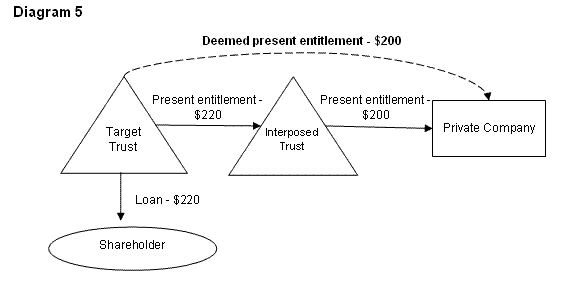
58. Although the company is taken to be presently entitled to the amount from the net income of the target trust at the time the company is, or becomes presently entitled to an amount from the net income of the first interposed trust, and the context of subsection 109XI(1) directs attention to the time of the section 109XA transaction, in determining the amount the company is taken to be entitled to from the net income of the target trust, the Commissioner will take into account any payment of the actual entitlements involved in the arrangement referred to in paragraph 109XI(1)(b) made before the lodgment date for the year of income in which the section 109XA transaction takes place.
59. This is consistent with other provisions in Division 7A which enable a taxpayer's Division 7A outcome for a particular income year to be determined at any time up to the relevant lodgment date. Determining the Division 7A outcome at the lodgment date allows taxpayers to identify Division 7A issues and to take appropriate action (such as putting a section 109N complying loan agreement in place after a relevant loan is made) at any time before the relevant lodgment date.
60. There will be situations where one or more of the present entitlements are paid before the lodgment date for the year of income in which the section 109XA transaction takes place. Accordingly, where there are no other additional factors to consider other than the amount of the relevant entitlements subsisting at the determination time, the Commissioner will determine that the amount the private company is taken to be entitled to from the net income of the target trust is the lesser of the amounts of the present entitlements that remained unpaid at the determination time.
61. In the above example the only relevant factors to consider were the amounts of the present entitlements and the amount of the deemed present entitlement. If, in addition, the trustee of Target Trust paid an amount of $100 to the trustee of the Interposed Trust before the Target Trust's lodgment date (reducing the amount the Interposed Trust was entitled to from the net income of the Target Trust that remained outstanding at that time to $120) then the amount the Commissioner will determine that the amount the Private Company is taken to be entitled to from the net income of the Target Trust (the deemed entitlement) will instead be only $120.
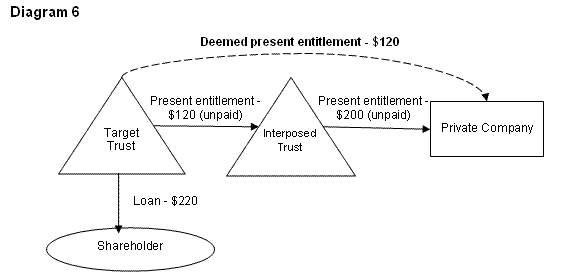
62. If the trustee of the Interposed Trust also paid an amount to the Private Company in partial satisfaction of its entitlement to an amount of income from the Interposed Trust, before the Target Trust's lodgment date, then that payment would also be taken into account. For example, if the amount paid to the Private Company before the determination time in partial satisfaction of its entitlement to an amount from the income of the Interposed Trust was $150, then the Commissioner would determine that the amount the Private Company was taken to be entitled to from the net income of the Target Trust (the deemed present entitlement) would only be $50.
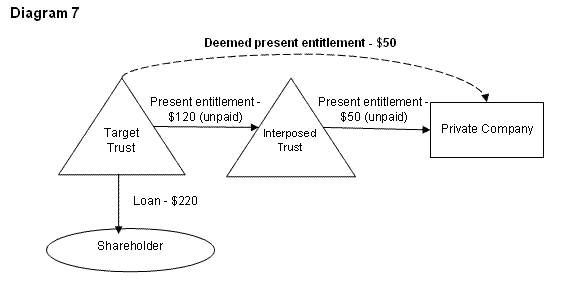
63. In particular cases there may be other matters that need to be taken into account. Accordingly, it does not follow that in all cases the amount that the private company is taken to be entitled to from the net income of the target trust will be the lesser of the amounts of the present entitlements that remained unpaid before the lodgment date for the year of income in which the section 109XA transaction takes place.
Appendix 2 - Your comments
64. You are invited to comment on this draft Determination. Please forward your comments to the contact officer by the due date.
65. A compendium of comments is also prepared for the consideration of the relevant Rulings Panel or relevant tax officers. An edited version (names and identifying information removed) of the compendium of comments will also be prepared to:
- (a)
- provide responses to persons providing comments; and
- (b)
- publish on the Australian Taxation Office website at www.ato.gov.au
Please advise if you do not want your comments included in the edited version of the compendium.
| Due date: | 4 February 2011 |
| Contact officer details have been removed following publication of the final ruling. | |
Footnotes
All legislative references in this draft Determination are to the ITAA 1936 unless otherwise stated.
Paragraph 8.2 of the Explanatory Memorandum to Tax Laws Amendment (2004 Measures No. 1) Bill 2004
Paragraph 109XA(1)(c) for payments, paragraph 109XA(2)(b) for loans and paragraph 109XA(3) for debts forgiven
Subdivision EB was introduced by Tax Laws Amendment (2010 Measures No.2) Act 2010 and applies in relation to payments made, loans made and debts forgiven on or after 1 July 2009.
Paragraph 109XI(2)(b)
Subsection 109XI(4)
Subsection 109XI(7)
Subsection 109XI(4)
Not previously issued as a draft
References
ATO references:
NO 1-2GOAK2N
Related Rulings/Determinations:
TR 2006/10
TR 2010/3
Subject References:
deemed dividends
disguised dividends
dividends
Legislative References:
ITAA 1936
ITAA 1936 Pt III Div 7A
ITAA 1936 Pt III Div 7A Subdiv EA
ITAA 1936 109N
ITAA 1936 109XA
ITAA 1936 109XA(1)
ITAA 1936 109XA(1)(c)
ITAA 1936 109XA(2)
ITAA 1936 109XA(2)(b)
ITAA 1936 109XA(3)
ITAA 1936 109XA(3)(b)
ITAA 1936 109XB
ITAA 1936 109XB(1)
ITAA 1936 Pt III Div 7A Subdiv EB
ITAA 1936 109XI
ITAA 1936 109XI(1)
ITAA 1936 109XI(1)(a)
ITAA 1936 109XI(1)(b)
ITAA 1936 109XI(1)(c)
ITAA 1936 109XI(1)(c)(i)
ITAA 1936 109XI(1)(c)(ii)
ITAA 1936 109XI(2)(b)
ITAA 1936 109XI(3)
ITAA 1936 109XI(4)
ITAA 1936 109XI(5)
ITAA 1936 109XI(6)(a)
ITAA 1936 109XI(6)(b)
ITAA 1936 109XI(7)
ITAA 1936 109Y(2)
Other References:
Explanatory Memorandum to Tax Laws Amendment (2004 Measures No. 1) Bill 2004
Tax Laws Amendment (2010 Measures No. 2) Act 2010
Explanatory Memorandum to Tax Laws Amendment (2010 Measures No. 2) Bill 2010

